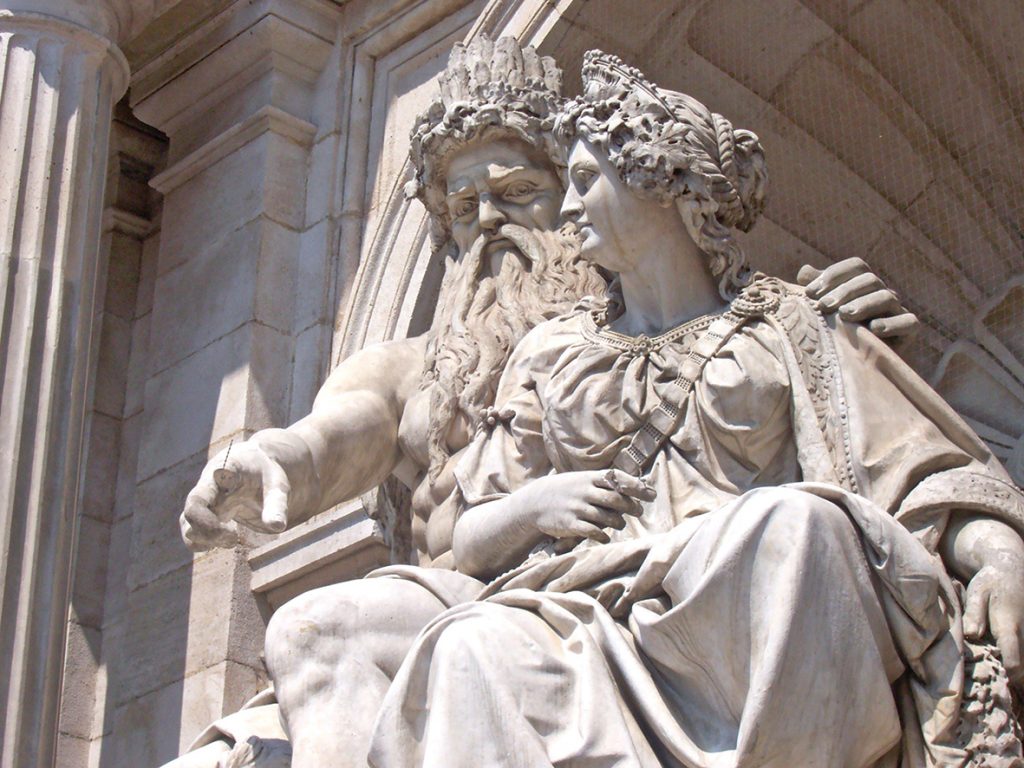Greek mythology is the body of myths originally told by the ancient Greeks and a genre of Ancient Greek folklore. These stories concern the origin and the nature of the world, the lives and activities of deities, heroes, and mythological creatures, and the origins and significance of the ancient Greeks’ own cult and ritual practices
Legends are like myths, but they are slightly different. While myths are completely made up, legends are based on events that really happened. The Greeks believed in gods and goddesses who, they thought, had control over every part of people’s lives. The Ancient Greeks believed that they had to pray to the gods for help and protection, because if the gods were unhappy with someone, then they would punish them. They made special places in their homes and temples where they could pray to statues of the gods and leave presents for them. Modern scholars study the myths in an attempt to shed light on the religious and political institutions of ancient Greece and its civilization and to gain an understanding of the nature of myth-making itself.

At the center of Greek mythology is the Pantheon of deities who were said to live on Mount Olympus, the highest mountain in Greece. From their perch, they ruled every aspect of human life. Olympian gods and goddesses looked like men and women (though they could change themselves into animals and other things) and were–as many myths recounted–vulnerable to human foibles and passions. The Greeks imagined that the gods lived together, as a family. They did not see them as perfect, but just like people. In the Greek myths the gods argue, fall in love, get jealous of each other and make mistakes.
“The most popular Greek Mythology figures include Greek Gods like Zeus, Poseidon & Apollo, Greek Goddesses like Aphrodite, Hera & Athena and Titans like Atlas”
There are many famous Greek myths and legends. Some of them are reused in stories and films today. In one, a woman called Pandora, the first woman whose curiosity brought evil to mankind, opens up a box full of all the bad things in the world and lets them out. Theseus and the Minotaur tell the story of a prince who chases a monster through a labyrinth to save the woman he loves. In another tale, two inventors called Icarus and Daedalus try to build wings so they can fly away from prison. Heracles is the adventurer who performed 12 impossible labors for King Eurystheus (and was subsequently worshipped as a god for his accomplishment). Pygmalion is the king who fell in love with an ivory statue. Arachne was the weaver who was turned into a spider for her arrogance. Handsome Trojan prince Ganymede became the cupbearer for the gods. Midas was the king with the golden touch, and Narcissus was the young man who fell in love with his own reflection. Perhaps the most exciting is Perseus and the Gorgon in which a man called Perseus has to kill a woman who can turn people to stone just by looking at them!
Monsters and “hybrids” (human-animal forms) also feature prominently in the tales: the winged horse Pegasus, the horse-man Centaur, the lion-woman Sphinx and the bird-woman Harpies, the one-eyed giant Cyclops, automatons (metal creatures given life by Hephaestus), manticores and unicorns, Gorgons, pygmies, minotaurs, satyrs and dragons of all sorts. Many of these creatures have become almost as well known as the gods, goddesses and heroes who share their stories.
“Greek Mythology is the set of stories about the gods, goddesses, heroes and rituals of Ancient Greeks”
The characters, stories, themes and lessons of Greek mythology have shaped art and literature for thousands of years. They appear in Renaissance paintings such as Botticelli’s Birth of Venus and Raphael’s Triumph of Galatea and writings like Dante’s Inferno; Romantic poetry and liberty; and scores of more recent novels, plays and films.
Around 700 BC, the poet Hesiod’s Theogony offered the first written cosmogony, or origin story, of Greek mythology. The Theogony tells the story of the universe’s journey from nothingness (Chaos, a primeval void) to being, and details an elaborate family tree of elements, gods and goddesses who evolved from Chaos and descended from Gaia (Earth), Ouranos (Sky), Pontos (Sea) and Tartaros (the Underworld). Later Greek writers and artists used and elaborated upon these sources in their own work. For instance, mythological figures and events appear in the 5th-century plays of Aeschylus, Sophocles and Euripides and the lyric poems of Pindar. Writers such as the 2nd-century BC Greek mythographer Apollodorus of Athens and the 1st-century BC Roman historian Gaius Julius Hyginus compiled the ancient myths and legends for contemporary audiences.
Did you know?
Many consumer products get their names from Greek mythology. Nike sneakers are the namesake of the Goddess of victory, for example, and the website Amazon.com is named after the race of mythical female warriors. Many high schools, college and professional sports teams (Titans, Spartans and Trojans, for instance) also get their names from mythological sources.
Some of the most important Greek Gods were: Zeus, the leader of the Gods, in charge of rain and the sky. Hera, Zeus’s wife, was the Goddess of marriage and childbirth. Poseidon, the God of the sea. Aphrodite, the Goddess of love. Hades, the God of the Underworld, where the dead lived. Ares, the God of war and battle. Hermes, the God of travel, hospitality and trade and Zeus’s personal messenger. Dionysus, the God of wine, pleasure and festivity. Athena, the Goddess of wisdom and defense. Apollo, God of prophecy, music and poetry and knowledge.